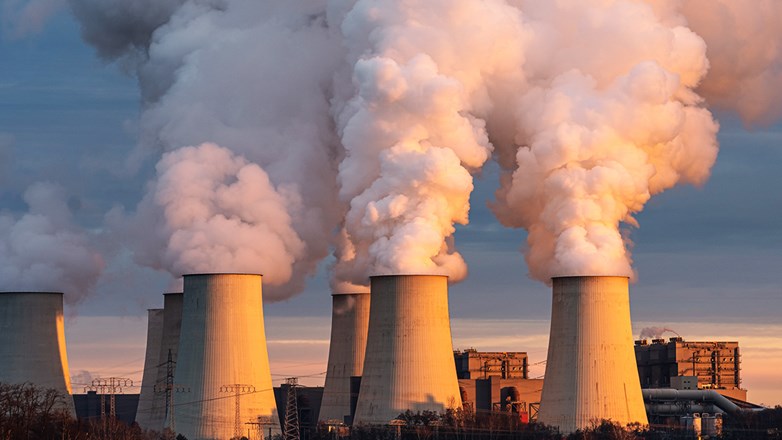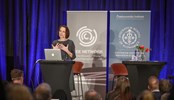Nuclear renaissance: Powering Sweden’s climate policy
The current Swedish government has put nuclear energy front and center of their climate policies, with a goal of two new reactors in commercial operation by 2035, and around ten new reactors by 2045. In light of this revived focus, this policy brief tackles the following question: is a large-scale expansion of nuclear energy an environmental and economically efficient solution to achieve Sweden’s climate policy objective of net zero emissions by 2045? To answer this, three important aspects are analyzed: potential emission reductions, the cost-effectiveness of such abatement, and the practicality of the proposed timelines. As a case study, we draw lessons from the large-scale build-out of nuclear power in France in the late 1970s. The results show that France significantly reduced emissions of carbon dioxide (CO2), at a net economic benefit, and with an average reactor construction time of around six years. However, today’s situation in Sweden contrasts sharply with France in the 1970s. Electricity production in Sweden is already low-carbon, the cost of alternative zero-carbon electricity sources has plummeted, and construction costs and timelines for nuclear power have steadily increased since the 1970s. Therefore, new reactors in Sweden are likely to yield only modest emission reductions at a relatively high abatement cost, and with construction times around two to three times longer than those achieved by France.
A renewed focus on nuclear energy
When the current government in Sweden, led by Prime Minister Ulf Kristersson, came into power in 2022, they swiftly made changes to Sweden’s environment and climate policies. The Ministry of Environment was abolished, transport fuel taxes were reduced, and the energy policy objective was changed from “100 percent renewable” to “100 percent fossil free”, emphasizing that nuclear energy was now the cornerstone in the government’s goal of reaching net zero emissions (Government Office 2023, Swedish Government 2023). This marked a new turn in Sweden’s relationship with nuclear energy: from the construction of four different nuclear power plants in the 1970s – of which three remain operational today – to the national referendum on nuclear energy in 1980, where it was decided that no new nuclear reactors should be built and that existing reactors were to be phased-out by 2010 (Jasper 1990).
Today’s renewed focus on nuclear energy, especially as a climate mitigation policy tool is, however, not unique to Sweden. As of 2022, the European Commission labels nuclear reactor construction as a “green investment”, the US has included production tax credits for nuclear energy in their 2023 climate bill the Inflation Reduction Act, and France’s President Macron is pushing for a “nuclear renaissance” in his vision of a low-carbon future for Europe (Gröndahl 2022; Bistline, Mehrotra, and Wolfram 2023; Alderman 2022).
France as a case study
In the 1970s, France conducted an unprecedented expansion of nuclear energy, which offers valuable insights for Sweden’s contemporary nuclear ambitions. Relying heavily on imported oil for their energy needs, France enacted a drastic shift in energy policy following the 1973 oil crisis. In the subsequent decade, France ordered and began the construction of 51 new nuclear reactors. The new energy policy – dubbed the Messmer Plan – was summarized by the slogan: “All electric, all nuclear” (Hecht 2009).
To support the expansion of new reactors, the French government made use of loan guarantees and public financing (Jasper 1990). A similar strategy has recently been proposed by the Swedish government, with suggested loan guarantees of up to 400 billion kronor (around $40 billion) to support the construction of new reactors (Persson 2022).
France’s emissions reductions and abatement costs
To make causal estimates of the environmental and economic effects of France’s large-scale expansion of nuclear energy, we need a counterfactual to compare with. In a recent working paper – titled Industrial Policy and Decarbonization: The Case of Nuclear Energy in France – I, together with Jared Finnegan from University College London, construct this counterfactual as a weighted combination of suitable control countries. These countries resemble France’s economy and energy profile in the 1960s and early 1970s, however, they did not push for nuclear energy following the first oil crisis. Our weighted average comprises five European countries: Belgium, Austria, Switzerland, Portugal, and Germany, with falling weights in that same order.
Figure 1 depicts per capita emissions of CO2 from electricity and heat production in France and its counterfactual – ‘synthetic France’ – from 1960 to 2005. The large push for nuclear energy led to substantial emission reductions, an average reduction of 62 percent, or close to 1 metric ton of CO2 per capita, in the years after 1980.
Figure 1. CO2 emissions from electricity and heat in France and synthetic France, 1960-2005.

Andersson and Finnegan (2024).
Moreover, Figure 1 shows that six years elapsed from the energy policy change until emission reductions began. This time delay matches the average construction time of around six years (75 months on average) for the more than 50 reactors that were constructed in France following the announcement of the Messmer Plan in 1974.
Table 1. Data for abatement cost estimates.
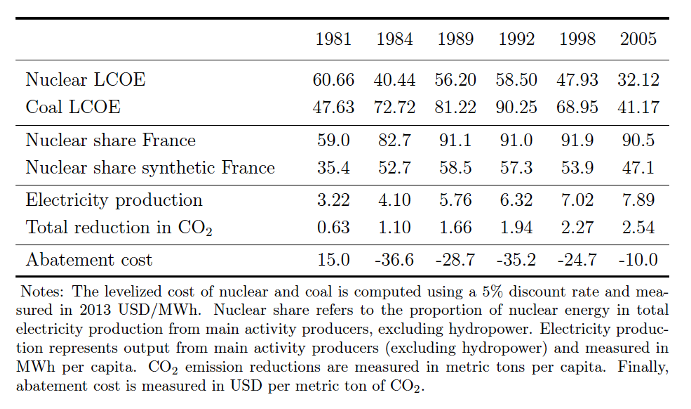
Andersson and Finnegan (2024).
Lastly, these large and relatively swift emission reductions in France were achieved at a net economic gain. Table 1 lists the data used to compute the average abatement cost (AAC): the total expenses incurred for the new policy (relative to the counterfactual scenario), divided by the CO2 emissions reduction.

The net average abatement cost of -$20 per ton of CO2 is a result of the lower cost of electricity production (here represented by the levelized cost of electricity (LCOE)) of new nuclear energy during the time-period, compared to the main alternative, namely coal, – the primary energy source in counterfactual synthetic France. LCOE encompasses the complete range of expenses incurred over a power plant’s life cycle, from initial construction and operation to maintenance, fuel, decommissioning, and waste handling. Accurately calculated, LCOE provides a standardized metric for comparing the costs of energy production across different technologies, countries, and time periods (IEA 2015).
Abatement costs and timelines today
Today, more than 50 years after the first oil crisis, many factors that made France’s expansion of nuclear energy a success are markedly different. For example, the cost of wind and solar energy – the other two prominent zero-carbon technologies – has plummeted (IEA 2020). Further, construction costs and timelines for new nuclear reactors in Europe have steadily increased since the 1970s (Lévêque 2015).
Figure 2 depicts the LCOE for the main electricity generating technologies between 2009 and 2023 (Bilicic and Scroggins 2023). The data is for the US, but the magnitudes and differences between technologies are similar in Europe. There are two important aspects of this figure. First, after having by far the highest levelized cost in 2009, the price of solar has dropped by more than 80 percent and is today, together with wind energy, the least-cost option. Second, the cost of nuclear has steadily increased, contrary to how technology cost typically evolves over time, meriting nuclear power the “a very strange beast” label (Lévêque, 2015, p. 44). By 2023, new nuclear power had the highest levelized cost of all energy technologies.
Regarding the construction time of nuclear reactors, these have steadily increased in both Europe and the US. The reactor Okiluoto 3 in Finland went into commercial operation last year but took 18 years to construct. Similarly, the reactor Flamanville 3 in France is still not finished, despite construction beginning 17 years ago. The reactors Hinkley Point C in the UK were initiated in 2016 and, after repeated delays, are projected to be ready for operation in 2027 at the earliest (Lawson 2022). Similarly, in the US, construction times have at least doubled since the first round of reactors were built. These lengthened constructions times are a consequence of stricter safety regulations and larger and more complex reactor designs (Lévêque, 2015). If these average construction times of 12-18 years are the new norm, Sweden will, in fact, not have two new reactors in place by 2035. Further, it would need to begin construction rather soon if the goal of having ten new reactors by 2045 is to be achieved.
Figure 2. Levelized Cost of Electricity, 2009-2023.
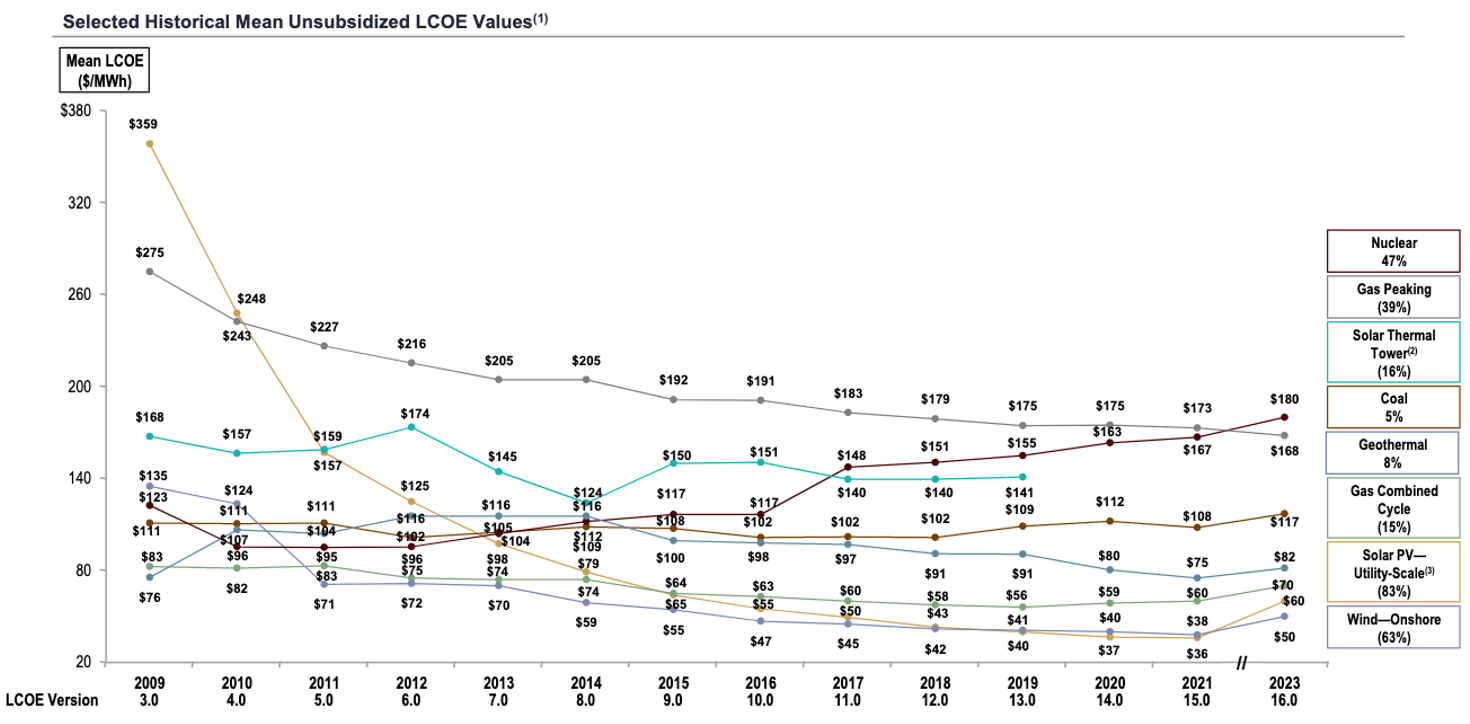
Source: Bilicic and Scroggins (2023).
Sweden’s potential emission reductions
The rising costs and extended construction times for new reactors are notable concerns, yet the crucial measure of Sweden’s new climate policy is its capacity to reach net zero emissions across all sectors. Figure 3 depicts per capita emissions of CO2 from electricity and heat production in Sweden and OECD countries between 1960 and 2018.
Figure 3. Sweden vs. the OECD average.
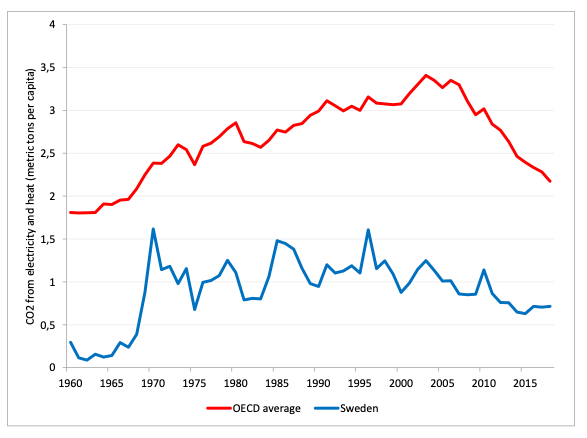
Source: IEA (2022).
In 2018, the OECD’s per capita CO2 emissions from electricity and heat averaged slightly over 2 metric tons. In comparison, Sweden’s per capita emissions at 0.7 metric tons are low and represent only 20 percent of total per capita emissions. Hence, the potential for substantial emission cuts through nuclear expansion is limited. By contrast, Sweden’s transport sector, with CO2 emissions more than two times larger than the emissions from electricity and heat, presents a greater chance for impactful reductions. Yet, current policies of reduced transport fuel taxes are likely to increase emissions. The electrification of transportation could leverage the benefits of nuclear energy for climate mitigation, but broader policies are then needed to accelerate the adoption of electric vehicles.
Conclusion
As Sweden rewrites its energy and climate policies, nuclear energy is placed front and center – a position it has not held since the 1970s. Yet, while nuclear energy may experience a renaissance in Sweden, it will not be the panacea for reaching net zero emissions the current government is hoping for. Expected emission reductions will be modest, abatement costs will be relatively high and, if recent European experiences are to be considered an indicator, the aspirational timelines are likely to be missed.
Considering these aspects, it’s imperative for Sweden to adopt a broader mix of climate policies to address sectors such as transportation – responsible for most of the country’s emissions. Pairing the nuclear ambitions with incentives for an accelerated electrification of transportation could enhance the prospects of achieving net zero emissions by 2045.
Reference
Disclaimer: Opinions expressed in events, policy briefs, working papers and other publications are those of the authors and/or speakers; they do not necessarily reflect those of SITE, the FREE Network and its research institutes.
Photo: Ugis Riba, Shutterstock
